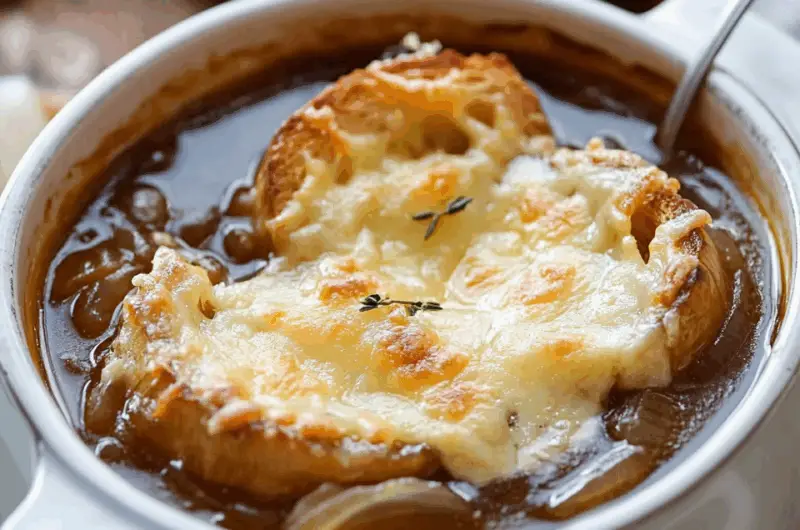The humble French Onion Soup is elevated to iconic status with a slow caramelization process that transforms simple onions into a rich, sweet base. This classic dish, deeply rooted in French culinary tradition, blends robust beef broth with golden onions, dry vermouth, and a hint of thyme for unmatched depth and aroma.
Topped with a crusty slice of baguette loaded with bubbling Gruyere and a sprinkle of Parmesan, each spoonful offers comfort, richness, and a cheesy crunch. Perfect for chilly evenings or impressing at a dinner party, this soup warms from the inside out and is guaranteed to become a cold-weather favorite.
Full Recipe:
-
6 large red or yellow onions (about 3 pounds), thinly sliced
-
4 tablespoons extra virgin olive oil
-
2 tablespoons butter
-
1 teaspoon sugar
-
1 teaspoon kosher salt
-
2 cloves garlic, minced
-
8 cups beef stock (or chicken stock, or a combination)
-
1/2 cup dry vermouth or dry white wine
-
2 bay leaves
-
1 tablespoon fresh thyme leaves (or 1/2 tsp dried thyme)
-
1/2 teaspoon freshly ground black pepper
-
2 tablespoons brandy (optional)
-
8 slices (1-inch thick) French bread or baguette
-
1 1/2 cups grated Gruyere cheese
-
Grated Parmesan cheese, for garnish
Directions:
-
Heat 3 tbsp olive oil in a large thick-bottomed pot over medium heat. Add the sliced onions and toss to coat. Cook, stirring often, for 15–20 minutes until softened.
-
Increase heat to medium-high. Add remaining 1 tbsp oil and the butter. Stir frequently until onions begin to brown, 20–40 minutes.
-
Sprinkle with sugar and salt. Continue to cook for 10–15 minutes more, until well browned. Add minced garlic and sauté for 1 minute.
-
Deglaze the pot with the wine or vermouth, scraping up all the browned bits.
-
Add stock, bay leaves, thyme. Bring to a simmer, cover, and cook on low heat for 30 minutes.
-
Season with salt and pepper to taste. Add brandy if using, and remove bay leaves.
-
Preheat oven to 450°F. Line a baking sheet, brush bread slices with olive oil, and toast for 5–7 minutes.
-
Sprinkle toasted bread with Gruyere and Parmesan. Return to oven until cheese is bubbly and lightly browned.
-
To serve, ladle soup into bowls and top with a cheesy toast. Alternatively, use ovenproof bowls and broil the soup with toast and cheese until bubbly.
Prep Time: 15 minutes | Cooking Time: 1 hour 15 minutes | Total Time: 1 hour 30 minutes
Kcal: 699 kcal | Servings: 4–6 servings
A Deep Dive into the Comforting Classic: French Onion Soup
French Onion Soup is more than just a meal—it’s an experience steeped in tradition, patience, and rich, layered flavors. For centuries, it has been a staple of French cuisine, celebrated not only for its simplicity but also for its sophistication. With humble beginnings, this soup has risen to become a gourmet favorite in restaurants and home kitchens alike.
Whether you’re new to French cooking or looking to refine a familiar recipe, understanding the roots and finer points of this dish will deepen your appreciation for each spoonful. Here’s a look at the history, techniques, and nuances that make French Onion Soup a perennial comfort classic.
A Brief History of French Onion Soup
Despite its elegant presentation in modern cuisine, French Onion Soup has rather rustic origins. It dates back to ancient times, but it was popularized in France during the 18th century as a meal for the poor. Onions were cheap, easy to grow, and available year-round, making them a staple in many kitchens. Combined with stale bread and basic broth, onion soup served as a hearty and economical meal.
Its transformation into the dish we know today—with deeply caramelized onions, rich broth, and melted cheese atop toasted bread—can be traced to Parisian restaurants in the 19th century. It became a favorite of late-night revelers and market workers at Les Halles, the city’s central marketplace, thanks to its warmth, affordability, and restorative properties.
Today, French Onion Soup is revered not only in France but around the world as a symbol of slow-cooked love and culinary sophistication.
The Essence of the Soup: Deep Caramelization
At the heart of a great French Onion Soup is one crucial process: caramelizing the onions. This is not a step to rush. Proper caramelization takes time—often close to an hour—and transforms pungent raw onions into a soft, sweet, golden mixture that becomes the soup’s foundational flavor.
Caramelization isn’t merely sautéing. It’s a chemical process where the natural sugars in the onions break down and form new flavor compounds. The result is a deeply rich, slightly sweet flavor that defines the soup. The addition of a small amount of sugar during the process helps to coax out and amplify the sweetness of the onions, while consistent stirring and heat control prevent burning.
This long, slow technique is where the true magic of French Onion Soup lies. Many cooks have tried to shortcut this step, only to find their soup lacking depth. The patience required is a small price for the immense reward of flavor.
Broth Matters: Choosing the Right Stock
The second pillar of a successful French Onion Soup is the broth. Traditional recipes call for beef stock, which offers a robust, savory depth that complements the sweetness of the caramelized onions. However, variations using chicken stock—or a blend of the two—are common and can yield delicious results as well.
Homemade stock is ideal, especially if made from roasted bones for added flavor. But for those short on time, high-quality store-bought broth can work in a pinch. The key is to taste the broth before using it. If it doesn’t taste good on its own, it won’t enhance your soup.
Some cooks add a spoonful of concentrated bouillon or umami-boosting condiments like Worcestershire sauce or soy sauce to deepen the flavor of weaker stocks. A splash of dry white wine or vermouth helps to deglaze the pan after caramelizing onions and adds brightness and acidity to balance the soup.
The Finishing Touch: Bread and Cheese
Perhaps the most iconic element of French Onion Soup is its topping—a slice of toasted bread smothered in melted Gruyere cheese. This garnish is more than decorative; it’s integral to the dish.
The bread, ideally a day-old French baguette or country loaf, is first toasted to prevent it from becoming soggy when floated atop the soup. Then, it’s placed over the soup and covered in cheese—typically Gruyere, known for its nutty and melty character—and sometimes a bit of Parmesan for extra sharpness.
The whole bowl is then broiled or baked until the cheese is melted, bubbling, and slightly browned. The result is a dish that combines the best of both worlds: hearty soup and crisp, cheesy toast. As you dig in, the cheese stretches and the bread absorbs the savory broth, creating a deeply satisfying textural contrast.
Customizations and Dietary Variations
While the classic recipe has endured for good reason, French Onion Soup is surprisingly versatile. For vegetarians, using a rich vegetable stock in place of beef still produces a delicious result, especially if enhanced with miso paste or roasted mushrooms.
If avoiding alcohol, the dry wine can be substituted with a little extra stock and a dash of vinegar for acidity. To reduce sodium, opt for low-sodium broth and season cautiously as the soup simmers.
Gluten-free? Simply use gluten-free bread for the topping. Vegan versions are possible, too—use plant-based butter, a rich vegetable broth, and meltable vegan cheese for the crouton. The flavor will differ, but with proper caramelization and seasoning, it’s still a deeply comforting dish.
Tips for the Perfect French Onion Soup
-
Be patient with the onions. Caramelization takes time. Use a wide, heavy-bottomed pot and stir often.
-
Use quality stock. Whether homemade or store-bought, the stock should taste good enough to enjoy by itself.
-
Toast the bread. This prevents the crouton from becoming too mushy in the soup.
-
Don’t skimp on the cheese. Gruyere melts beautifully and adds a signature nuttiness. A touch of Parmesan enhances the flavor.
-
Use oven-safe bowls. This allows you to finish the dish under the broiler for that irresistible cheese crust.
Why This Dish Endures
The appeal of French Onion Soup goes far beyond taste. It’s a dish that invites you to slow down. From slicing and caramelizing the onions to simmering the broth and broiling the final creation, every step demands time and care. But in exchange, you get a meal that feeds not only the stomach but the soul.
The aroma of onions browning, the sight of cheese bubbling on a golden crouton, and the warm steam rising from the bowl—these are sensory experiences that evoke comfort, nostalgia, and satisfaction.
French Onion Soup is perfect for holidays, winter dinners, or anytime you’re craving something hearty and homemade. It’s the kind of dish you serve to impress guests or to reward yourself after a long day. It’s elegant enough for a dinner party, yet humble enough for a quiet night at home.
Conclusion
French Onion Soup remains a timeless treasure in the culinary world, proving that simple ingredients—when treated with respect and patience—can yield extraordinary results. It’s a celebration of classic French technique, of comfort food elevated, and of tradition preserved through generations.
Whether you’re introducing it to your dinner table for the first time or returning to an old favorite, this soup has a way of warming hearts and bringing people together. Mastering it means mastering a piece of culinary heritage—and serving up a bowl of love in every spoonful.








